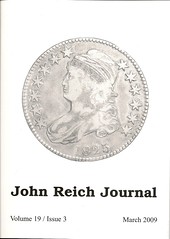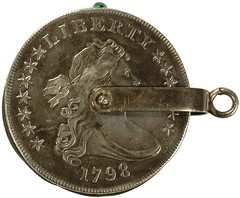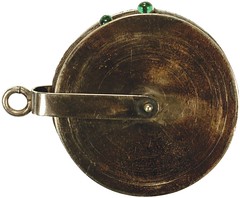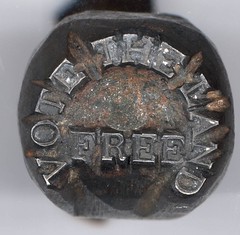
PREV ARTICLE
NEXT ARTICLE
FULL ISSUE
PREV FULL ISSUE
GLEANINGS FROM RECENT NUMISMATIC PERIODICALS The cover article in the latest Brasher Bulletin, the newsletter of the Society of Private and Pioneer Numisamtics (SPPN), is a piece by David McCarthy unveiling new information about the most famous of all U.S. private gold coins. The title is Alexander Hamilton and the World's Most Desirable Coin - Recently Discovered Hamilton Letters Reveal Important Information about the Mysterious Brasher Doubloon. The cover article in the latest Brasher Bulletin, the newsletter of the Society of Private and Pioneer Numisamtics (SPPN), is a piece by David McCarthy unveiling new information about the most famous of all U.S. private gold coins. The title is Alexander Hamilton and the World's Most Desirable Coin - Recently Discovered Hamilton Letters Reveal Important Information about the Mysterious Brasher Doubloon. However, unbeknownst to numismatic researchers, a contemporary account of Brasher's Doubloon's existed, overlooked in the papers of then Treasury Secretary, Alexander Hamilton. Written during the summer of 1791, a pair of letters sheds some light upon the nature of these mysterious coins. The article recounts an exchange of letters between Hamilton and William Seton, the cashier of the Bank of New York. ... the events that followed make it obvious that Brasher and his coins made quite an impression on Hamilton, for within a matter of months, Hamilton stopped using the services of assayer Jose Ruiz de Silva, and hired Brasher to conduct assays on behalf of the first United States Mint at Philadelphia. As such, Brasher's assays and the knowledge that he gleaned from making his doubloons have had an impact on every gold coin struck in the United States between 1795 and 1933. McCarthy's Brasher research is also the cover article on the April 2009 issue of The Numismatist from the American Numismatic Association. Other great articles in the issue include Nancy Oliver & Richard Kelly's article on The Selby Refinery Works Robbery, an interesting tale of how a single man stole nearly half a ton of gold. Also in the issue is John Kraljevich's Early American Money column, focusing this month on the "First Family of Bank Note Printing", the Green family. For nearly a century, the Greens could rightly claim they made more money than any other family in America. Their notes funded several colonial conflicts and the American Revolution. In Vermont, their press remain, while in Maryland, thousands of pieces of type survive, all excavated from te backyard pit of the Jonas Green house, now a bed-and-breakfast in Annapolis. Outspoken, patriotic, talented and adventurous, the men and women of the Green family left a long legacy in ink and paper to be collected by students of history today.  I would also like to mention W. David Perkins' article in the March 2009 issue of the John Reich Journal titled A Most Interesting 1798 B-19 Dollar I would also like to mention W. David Perkins' article in the March 2009 issue of the John Reich Journal titled A Most Interesting 1798 B-19 Dollar Last summer, a dealer friend called me and asked if I had seen a few neat items that were being offered in the June 5, 2008 Bowers & Merena Baltimore Auction sale. I had not, and quickly went online to view the three lots he referenced. Lot 42 especially interested me, and armed the dealer as my agent to bid in on this piece. After all, the Dollars of 1798 are a specialty of mine. Lot # 42 A Sewing Needle Cushion Wheel Constructed Using a 1798 Large Eagle Draped Bust Silver Dollar. VF. One of the most interesting items of its kind that this cataloger has ever handled, this needle cushion wheel has a blank base with a 1798 Large Eagle Dollar serving as the top.  The coin itself grades EF Details, and several pins are still stuck into the cushion. Additionally, the handle that once attached this cushion wheel to (probably) a sewing machine stand is still present and fully functional. All metal components are originally and attractively toned in steel-gray patina, and there really are no significant problems. The amount of detail remaining to the Dollar suggests that this fascinating piece was constructed no later than the early 19th century. The coin itself grades EF Details, and several pins are still stuck into the cushion. Additionally, the handle that once attached this cushion wheel to (probably) a sewing machine stand is still present and fully functional. All metal components are originally and attractively toned in steel-gray patina, and there really are no significant problems. The amount of detail remaining to the Dollar suggests that this fascinating piece was constructed no later than the early 19th century.   Interesting piece! Back on the numismatic research front, equally as important as the recent Brasher Doubloon findings is Bob Merchant's article in the February 2009 issue of the TAMS Journal, the official publication of the Token and Medal Society. The article, about a famous (and mysterious) counterstamp seen on U.S. coins, is titled Vote the Land free: A Recent Discovery Solves the Mystery. Over the years several numismatists have researched this countermark. But no one has been able to attribute it to a specific issuer, with absolute positive proof, until now. Due to a recent discovery, the origin of the countermarked coins that bear the phrase 'VOTE THE LAND FREE' can now be positively attributed to the national reform Association (NRA). This political association was organized in New York during the early month of 1844.   Bob located the original punch used to make the counterstamps at the Kansas Historical Society, and paid to have photos taken. Images of the punch are now on the society's web site. Above is an image of one of the coins alongside a mirror image of the punch. To see the complete punch images at the Kansas Historical Society, see: Vote the land free (www.kansasmemory.org/item/212514) Congratulations to the authors and editors of these and other great articles appearing in the numismatic press. Excellent work! -Editor Wayne Homren, Editor The Numismatic Bibliomania Society is a non-profit organization promoting numismatic literature. See our web site at coinbooks.org. To submit items for publication in The E-Sylum, write to the Editor at this address: whomren@gmail.com To subscribe go to: https://my.binhost.com/lists/listinfo/esylum All Rights Reserved. NBS Home Page Contact the NBS webmaster 
|